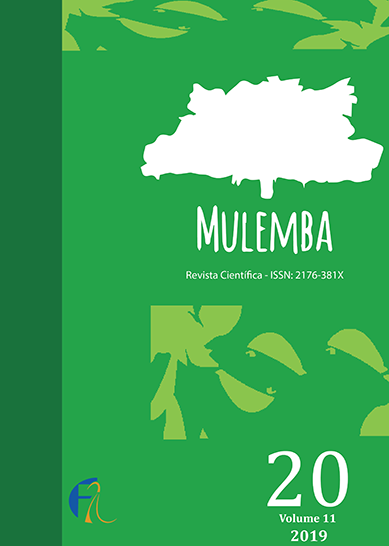Testemunho de um inventário
DOI:
https://doi.org/10.35520/mulemba.2019.v11n20a23352Parole chiave:
Honwana, literatura moçambicana, ficção, testemunho literário.Abstract
Em “Inventário de imóveis e jacentes”, inserido na coletânea de contos Nós matámos o Cão-Tinhoso (1964), único livro de Luís Bernardo Honwana, um narrador infantil insone decide inventariar os bens familiares. Mas esse inventário desmascara-se para o leitor atento como um exercício de invenção da realidade e de si mesmo pela criança que mistura realidade e ficção, ou melhor, que movimenta as categorias de real, fictício e imaginário, como propõe Wolfgang Iser. O jogo serve ainda para uma reflexão sobre o testemunho literário quando este conceito designa algo que se produz no próprio tecido da escrita, na forma artística assumida pelas palavras.
Downloads
Riferimenti bibliografici
ARISTÓTELES. Poética. Lisboa: Fundação Calouste Gulbenkian, 2008.
BACHELARD, Gaston. O ar e os sonhos: ensaio sobre a imaginação do movimento. São Paulo: Martins Fontes, 2001.
BARROS, Manoel de. Poesia completa. São Paulo: Leya, 2010.
CAMPOS, Haroldo de. “Kafka: um realismo de linguagem?”. In: ______. O arco-íris branco: ensaios de literatura e crítica. Rio de Janeiro: Imago, 1997, p. 129-138.
CESAR, Ana Cristina. Crítica e tradução. São Paulo: Companhia das Letras, 2016.
GADAMER, Hans-Georg. Verdade e método: traços fundamentais de uma hermenêutica filosófica. Petrópolis: Vozes, 1998.
HONWANA, Luís Bernardo. Nós matámos o Cão-Tinhoso. São Paulo: Ática, 1980.
ISER, Wolfgang. “Os atos de fingir ou o que é fictício no texto ficcional”. In: LIMA, Luiz Costa (org.). Teoria da literatura em suas fontes. v. 2. Rio de Janeiro: Civilização Brasileira, 2002, p. 955-985.
NIETZSHE, Friedrich Wilheim. Assim falou Zaratustra: um livro para todos e para ninguém. São Paulo: Companhia das Letras, 2011.
SCHWARZ, Roberto. O pai de família e outros estudos. São Paulo: Companhia das Letras, 2008.
##submission.downloads##
Pubblicato
Fascicolo
Sezione
Licenza
Autores que publicam nesta revista concordam com os seguintes termos:
- Autores mantém os direitos autorais e concedem à revista o direito de primeira publicação, com o trabalho simultaneamente licenciado sob a Licença Creative Commons Attribution que permite o compartilhamento do trabalho com reconhecimento da autoria e publicação inicial nesta revista.
- Autores têm autorização para assumir contratos adicionais separadamente, para distribuição não-exclusiva da versão do trabalho publicada nesta revista (ex.: publicar em repositório institucional ou como capítulo de livro), com reconhecimento de autoria e publicação inicial nesta revista.
- Autores têm permissão e são estimulados a publicar e distribuir seu trabalho online (ex.: em repositórios institucionais ou na sua página pessoal) a qualquer ponto antes ou durante o processo editorial, já que isso pode gerar alterações produtivas, bem como aumentar o impacto e a citação do trabalho publicado (Veja O Efeito do Acesso Livre).

